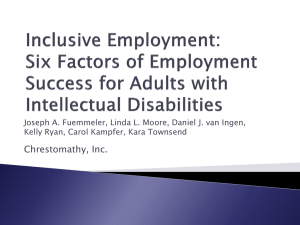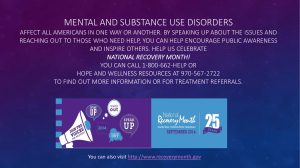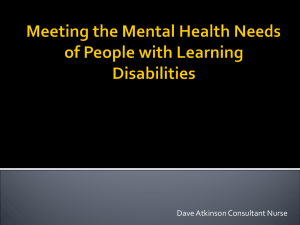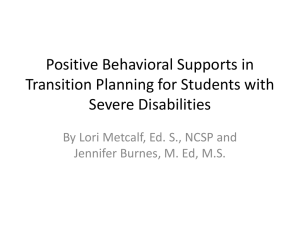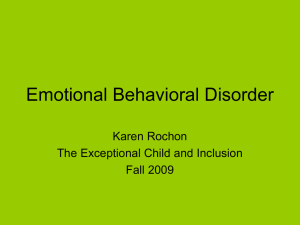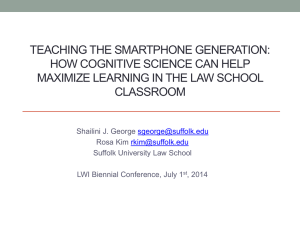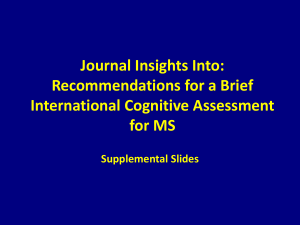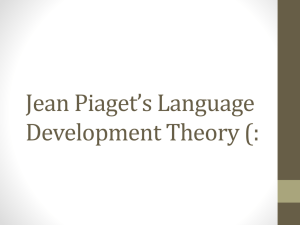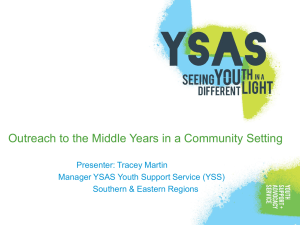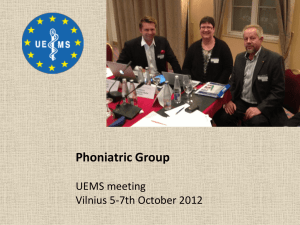Cognitive Behavioral Interventions in the School
advertisement
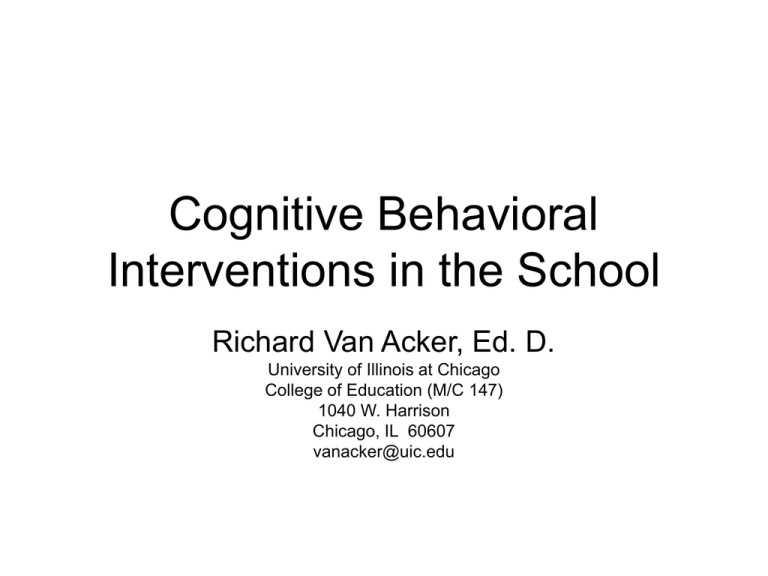
Cognitive Behavioral Interventions in the School Richard Van Acker, Ed. D. University of Illinois at Chicago College of Education (M/C 147) 1040 W. Harrison Chicago, IL 60607 vanacker@uic.edu A Case for Need….. • Among children ages 9-17, almost 21% have a diagnosable mental health or addictive disorder; – of these 11% have a significant impairment and – 5% have an extreme functional impairment. (Surgeon General’s Report) • Less than 1 in 5 children or adolescents with mental health problems receives mental health services in any given year. (President’s New Freedom Commission). • While only 16% of all children and youth in need receive mental health services, 70-80-receive that care in the school setting (Rones & Hoagwood, 2000). • The public school has become the de facto national mental health system for children and youth. The population of children and youth in the public school is changing… • Greater exposure to risk factors for the development of emotional and mental health disorders: – – – – – – – – – – – Poverty Minimal parental education Marital discord or family dysfunction Ineffective parenting Coercive discipline Child maltreatment (abuse and neglect) Poor physical health of child or parent Parental mental illness School failure Social rejection or isolation from peers Lack of meaningful interaction with a significant adult Maltreatment and Risk Posttraumatic Stress Syndrome Infancy Attachment Disorders Early to Middle Childhood Internalizing Disorders Externalizing Disorders SeparationAnxiety Disorders ADHD Mild Depression Chronic PTSD Major Depression Adolescence to Adulthood Oppositional Defiant Disorder Suicide Attempts Conduct Disorders Cognitive and Learning Disorders Pervasive Developmental Disorders Poor School Performance Personality Disorders Increased Risk to Maltreat One’s Children The Prevalence of Common Mental Health Disorders Affecting Children and Youth Disorder Number of Children/Youth Affected Anxiety 8 to 10 out of 100 Conduct 7 out of 100 Depression 6 out of 100 Learning 5 out of 100 Attention 5 out of 100 Eating 1 out of 150 Substance Abuse Not known CMHS. Mental, emotional, and behavior disorders in children and adolescents. The Center for Mental Health Services. Accessed at www.mentalhealth.org/publications/allpubs/CA-0006/default.asp As a result of the growing number of students with emotional and mental health concerns… • School personnel (school-based clinicians, teachers and administrators) are being called upon to have a greater understanding of these disorders, and • To employ prevention and intervention strategies that have been empirically validated to be effective. Why should the school be involved in addressing children’s mental health needs? • Mental health significantly impacts both the social/emotional and academic outcomes of students. • Children spend over half of their waking hours in school – this makes the educators front line agents in recognizing and implementing treatments. • The economic and racial segregation found in schools enables the targeting of those populations with the greatest need. • Children and youth do not leave their emotional and mental health needs at the gate when they enter the school. • The public school remains the only mandated ‘noreject’ service agency for all children. Key Processes in Prevention and Intervention • Build relationships (student, family, school staff, other) • Reduce or build boundaries to stress and risk • Build protective factors • Educate in key cognitive behavioral skills • Use evidence-based practices • Emphasize strong outcome evaluation and continuous program improvement. • Advocate for program improvement and growth Cognitive-Behavior Intervention • Is not a singular approach, but rather a body of methods and strategies used to change behavior. • Behavior change is accomplished through the active engagement of the child’s understanding and taking control of their thoughts, beliefs, feelings, and behaviors. Cognition Behavior Effective Treatment Mental Health Disorders • Multimodal approach Medication Behavioral Interventions CognitiveBehavioral Interventions Common Cognitive and Behavioral Interventions for Children and Youth Cognitive Interventions • Examining and testing the evidence • Challenging cognitive distortions • Reattribution • Decatastrophizing • Self-Instruction or Self-Talk • Self-regulation • Problem solving training • Desensitization imagery • Thought stopping • Refocusing • Evaluating pros and cons Behavioral Interventions • Contingency management – Reinforcement (DR_) – Punishment – Shaping • Behavioral rehearsal (role playing) • Social skills training • Token economy • Modeling • Self-monitoring • Behavioral experiment • Systematic desensitization • Activity scheduling In effective intervention – cognitive-behavioral and behavioral interventions often play complementary roles. Factors impacting the selection of an intervention strategy • Age • Development • Presenting problem CognitiveBehavioral Interventions Behavioral Interventions Age and Cognition Some Common CBI Interventions Self-Regulation/Self-Control • Self-monitoring – the ability to collect data or otherwise identify one’s own thoughts and behavior. • Self-evaluation – to be able to judge one’s performance accurately against some standard of performance. • Self-reinforcement – the ability to deliver self-praise or a reward contingently on the display of a specified desired behavior. Self-Instruction Training (Meichenbaum & Goodman 1971) • Cognitive Modeling – the teacher performs a task • • • • while talking aloud; the student observes. Overt External Guidance – The student and teacher both perform the task while talking aloud together. Overt Self-Guidance – The student performs the task using the same verbalizations as the teacher (talk together). Faded Self-Guidance – The student whispers the instructions (often in an abbreviated form) while going through the task. Covert Self-Guidance – The student performs the task, guided by self-speech. Attribution Retraining • Needed when student displays dysfunctional maladaptive or irrational explanations for why he or she is performing well or poorly. • These explanations have implications for behavioral persistence, expectancies for future performance, and emotional reactions to success and failure. • For example, students who attribute their success to external, unstable factors and their failures to internal stable, or global factors. • Two phases to the process: – Student is set up to experience some degree of failure (care must be taken here). – Student is taught to make statements that attribute the contrived failure to insufficient effort (student must have the skill required to be successful) Problem- Solving Training • Problem Identification – component skills involve problem sensitivity or the ability to “sense” the presence of a problem by identifying “uncomfortable” feelings. • Alternative Thinking – the ability to generate multiple alternative solutions to a given interpersonal problem situation. • Consequential Thinking – the ability to foresee the immediate and more long-range consequences of a particular alternative and to use this information in the decision-making process. • Means-Ends Thinking – the ability to elaborate or plan a series of specific actions ( a means) to attain a given goal (ends), to recognize and devise ways around potential obstacles, and to use a realistic time framework in implementing steps towards the goal. Cognitive Restructuring • Goal: Target maladaptive thoughts –Negative Schemas • Ways of thinking that lead individuals to perceive and interpret experiences in a negative manner 1. Automatic, often occur rapidly in certain situations and may be outside of person’s awareness 2. Involve discrete predictions or interpretations of a given situation 3. Develop out of negative experiences Bibliotherapy – provide examples of new schema Cognitive Restructuring (Cont.) Altering irrational, dysfunctional or maladaptive patterns of thought. •Process: – Identify and understand the triggering events causing the student difficulty. – Identify and understand the student’s thoughts in response, and – Help the student alter the irrational, dysfunctional or maladaptive thoughts. Common Cognitive Distortions Encountered in Children and Youth • Dichotomous Thinking- The student views situation in only two categories rather than on a continuum. • Overgeneralization – The student sees a current event as being characteristic of life in general, instead of one situation among many. • Mind Reading – The student believes he or she knows what others are thinking about him or her without any evidence. • Emotional Reasoning – The student assumes that his or her feelings or emotional reactions reflect the true situation. Common Cognitive Distortions Encountered in Children and Youth (Cont.) • Disqualifying the Positive – The student discounts positive experiences that conflict with his or her negative views. • Catastrophizing – The student predicts that future situations will be negative and treats them as intolerable catastrophes. • Personalization – The student assumes that he or she is the cause of negative circumstances. • Should Statements – The student uses should or must to describe how he/she or others are to behave or act. Common Cognitive Distortions Encountered in Children and Youth (Cont.) • Comparing – The student compares his or her performance to others (often to higher performing or older students) and focuses on the discrepancy. • Selective Abstraction – The student focuses attention to one detail (usually negative) and ignores other relevant aspects of the situation. • Labeling – The student attaches a global label to describe him- or herself rather than looking at behaviors, attributes, and actions CBI in the school can be delivered… • Individually • In small groups, and/or • In large groups • Making it an excellent fit for RtI and PBIStype school-wide efforts. School-Wide Epidemiological Approaches Targeted Interventions Individualized Plans Selected Interventions Coping Cats (Kendall) Anxiety Friends (Bartlett) Social Problem Solving CBT for Impulsive Children (Kendall & Braswell) ADHD Universal Interventions I Can Problem Solve (Shure , 2001) Olweus Bullying Prevention (Olweus & Limber, 1999) Goal of School-wide Programming -Strengthen Protective Factors• Strengthening peer relationships • Increasing self-monitoring and selfregulation skills • Improving parent-child, and teacherstudent relationships • Promoting positive school climate • Increasing school success Learn to “Double Dip” Combine academic and social emotional instruction when teaching Bibliotherapy Index • Identify critical needs and select readings that have this as the theme. • Employ instructional strategies that allow students to learn and practice social skills. • Whenever possible use instructional consequences for behavioral infractions Build Capacity Within Your Community • Approach the United Way for assistance in securing community agency support. – “How do you serve the students in our public schools directly?” – Social services within the school • Identify business partners that can provided needed person power (e.g., for mentors, etc) or for tangible support (funding, possible reinforcers). Group Activity Each group will select either Option 1 or 2 and discuss in some detail a plan to address the situation using a combination of strategies including cognitive behavioral strategies. Be prepared to have one group member who can report out to the larger group. • Option #1 – Read the vignette related to the student with Oppositional Defiant Disorder. – An FBA determined that the student engages in many of these behaviors for power and control and to earn peer recognition. – Obviously his family dynamics play a role in this behavior as well. – Discuss how you would address this behavior employing both behavioral and cognitive behavioral intervention strategies. • Option #2 – Your school has a problem with bullying and children and youth being disrespectful to one another. You are part of a team that has been given the task of developing a schoolwide program to address the problem. – Identify universal and selected strategies that you might implement and discuss how you will build practice and feedback to both teachers and students related to the display of both desired and undesired behaviors across the course of each day. For More Information • The Center for Health and Health Care in Schools www.healthinschools.org • Center for Mental Health Services http://www.mentalhealth.org/cmhs/ • Mental Health: The Surgeon General's Report http://www.surgeongeneral.gov/library/mentalhealth/toc.html#chapter3 • National Institute of Mental Health http://www.nimh.nih.gov • University of Maryland Center for School Mental Health Assistance http://csmha.umaryland.edu/ • School Mental Health Project http://smhp.psych.ucla.edu 1. Dream 2. Goal 3. Now 4. People to enroll 5. Ways to build strength 6. Charting ACTIONS 7. Next month’s work 8. Committing the first step DREAM NOW People Ways Commit- Next ting to Month’s Charting to 1st to work Actions step Build enroll GOAL Strength Situate yourself in a very positive future -- picture it clearly, then think backwards (Falvey, Forrest, Pierpoint, & Rosenberg. 1992)

